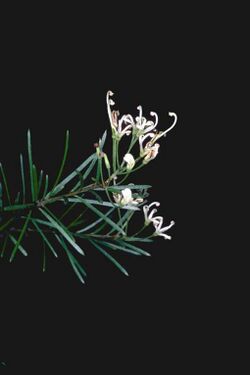Biology:Grevillea inconspicua
| Grevillea inconspicua | |
|---|---|

| |
| In the Australian National Botanic Gardens | |
| Scientific classification | |
| Kingdom: | Plantae |
| Clade: | Tracheophytes |
| Clade: | Angiosperms |
| Clade: | Eudicots |
| Order: | Proteales |
| Family: | Proteaceae |
| Genus: | Grevillea |
| Species: | G. inconspicua
|
| Binomial name | |
| Grevillea inconspicua Diels[3]
| |
Grevillea inconspicua, commonly known as Cue grevillea,[2] is a species of flowering plant in the family Proteaceae and is endemic to the central-west of Western Australia. It is a prickly, densely-branched shrub with linear leaves and clusters of off-white to silvery grey flowers.
Description
Grevillea inconspicua is a prickly, densely-branched shrub that typically grows to a height of 0.6–1 m (2 ft 0 in–3 ft 3 in) and has a wiry branches. The leaves are linear, 10–50 mm (0.39–1.97 in) long and 0.8–1.3 mm (0.031–0.051 in) wide with the edges rolled under, enclosing the lower surface. The flowers are arranged in clusters of six to eight on the ends of branches and are off-white to silvery-grey, the pistil 9.5–11.5 mm (0.37–0.45 in) long with a white to pale pink style. Flowering occurs from June to September and the fruit is a follicle 7–14 mm (0.28–0.55 in) long.[2][4]
Taxonomy
Grevillea inconspicua was first formally described in 1904 by Ludwig Diels in Ernst Georg Pritzel's Botanische Jahrbücher für Systematik, Pflanzengeschichte und Pflanzengeographie.[5][6] The specific epithet (inconspicua) means "undistinguished", referring to the flowers.[7]
Distribution and habitat
Cue grevillea occurs in the central-west area of Western Australia near Cue, Meekatharra the Weld Range and Sandstone, where it grows in shrub communities often along drainage lines and gullies.[2][4]
Conservation status
Grevillea inconspicua is listed as Least Concern on the IUCN Red List of Threatened Species.[1] It is also listed as "Priority Four" by the Government of Western Australia Department of Biodiversity, Conservation and Attractions,[2] meaning that it is rare or near threatened.[8]
Use in horticulture
The shrub is suitable for use in a water wise garden, although it is not showy, it can take full sun and well drained soils are recommended.[9]
See also
References
- ↑ 1.0 1.1 Olde, P.; Keighery, G. (2020). "Grevillea inconspicua". IUCN Red List of Threatened Species 2020: e.T113021395A113308116. doi:10.2305/IUCN.UK.2020-2.RLTS.T113021395A113308116.en. https://www.iucnredlist.org/species/113021395/113308116. Retrieved 24 January 2024.
- ↑ 2.0 2.1 2.2 2.3 2.4 "Grevillea inconspicua". FloraBase. Western Australian Government Department of Parks and Wildlife. https://florabase.dpaw.wa.gov.au/browse/profile/2019.
- ↑ "Grevillea inconspicua". Australian Plant Census. https://biodiversity.org.au/nsl/services/apc-format/display/70618.
- ↑ 4.0 4.1 "Grevillea inconspicua". Australian Biological Resources Study, Department of Agriculture, Water and the Environment: Canberra. https://profiles.ala.org.au/opus/foa/profile/Grevillea%20inconspicua.
- ↑ "Grevillea inconspicua". APNI. https://id.biodiversity.org.au/instance/apni/481294.
- ↑ Diels, Ludwig (1904). "Fragmenta Phytographiae Australiae occidentalis. Beitrage zur Kenntnis der Pflanzen Westaustraliens, ihrer Verbreitung und ihrer Lebensverhaltnisse". Botanische Jahrbücher für Systematik, Pflanzengeschichte und Pflanzengeographie 35 (1): 153. https://www.biodiversitylibrary.org/item/660#page/158/mode/1up. Retrieved 22 May 2022.
- ↑ Sharr, Francis Aubi; George, Alex (2019). Western Australian Plant Names and Their Meanings (3rd ed.). Kardinya, WA: Four Gables Press. p. 223. ISBN 9780958034180.
- ↑ "Conservation codes for Western Australian Flora and Fauna". Government of Western Australia Department of Parks and Wildlife. https://www.dpaw.wa.gov.au/images/documents/plants-animals/threatened-species/Listings/Conservation%20code%20definitions.pdf. Retrieved 22 May 2022.
- ↑ Alan Windust (2003). Waterwise House and Garden: A Guide for Sustainable Living. Landlinks Press. ISBN 9780643099791.
Wikidata ☰ Q15580938 entry
 |



